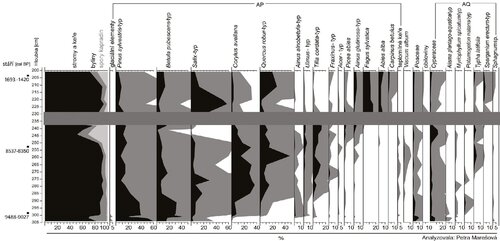Nature Conservation 2024 — 30. 5. 2024 — Research, Surveys and Data Management — Print article in pdf
Ten-thousand-year History of a Pool – What Peat Hides in the Březina Nature Reserve in the České Stř
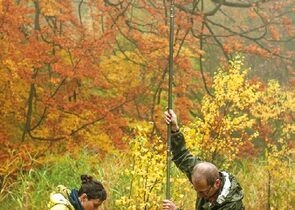
Sediments of water bodies and peatlands harbour archives of the past. Investigation of them may provide information about what past ecosystems looked like. Which changes have natural ecosystems undergone over thousands of years? How have they responded to climate change or shifts in landscape exploitation by humans? Answers to these questions may help setting limitations to site management as well as defining a baseline for the natural ecosystem restoration. They can show us which changes have taken place in a particular area many times in the past and what, on the other hand, is an unprecedented present issue requiring active management. We will show the possible application of palaeoecological research in nature conservation on the example of the Březina Nature Reserve (NR) and Site of European Importance (SEI, pursuant to Act No. 114/1992 Gazette on Nature Conservation and Landscape Protection, as amended later, the term for Site of Community Importance, SCI, later Special Areas of Conservation, SAC, under the European Union’s Habitats Directive), a unique wetland in the České Středohoří/Central Bohemian Uplands. It may be an example for other sites at which sediment elimination often destroys the heritage which may turn out to be a basic natural archive if carefully investigated.
The Březina Nature Reserve peat-bog (Fig. 1) is a unique site in the České Středohoří/Central Bohemian Uplands Protected Landscape Area (PLA), where specially protected and rare species occur, e.g. the Round-leaved sundew (Drosera rotundifolia), Bladderwort (Utricularia australis), Broad-leaved cotton grass (Eriophorum latifolium), Northern crested newt (Triturus cristatus), Smooth newt, also known as Common newt (Lissotriton vulgaris), and the Moor frog (Rana arvalis). The peat-bog and adjacent beech forest ecosystems (“protection of the entire geobiocenosis”) was the conservation objective already in the 1960s. The beech forest is up to 190 years old and is one of the oldest in the České Středohoří/Central Bohemian Uplands. By implementation of the European Union’s Natura 2000 network and the SERI/SCI/Sac designation, the Northern crested newt was designated as conservation object. The pool has silted strongly, particularly in the past decade, and due to long periods of drought in 2019 and 2020, its water table has lowered. As a result, expansive species have spread there: the Common sallow (Salix cinerea) at the peat-bog margin, Common reed (Phragmites australis), Bulrush (Typha latifolia), and sedges (Carex spp.). The pool with an open surface and floating islets of sphagnum (Sphagnum spp.) is becoming encroached. As part of the Březina NR Management Plan for the period 2014–2026 and earlier plans, several minor interventions have been carried out to keep the water surface open in order to maintain the Bladderwort and Northern crested newt populations, and a major intervention has been planned. However, more extensive work was abandoned with respect to the fact that the peat-bog could be much older than was generally assumed (formation of the current pool during the levelling of the forest road margin in 1952). At the same time, a study was commissioned to reveal the actual age and historical development of the site, particularly its vegetation. Vigorous management measures may irreversibly damage a record which has no parallels in a wider area. The importance of sediments and information about the long-term development of a site should always be taken into consideration when prioritising management measures. To determine age and development of a site, material settled in the past can be used. This includes sediments deposited on the bottom of not only lakes and fishponds, but also marshes, fens, and peat-bogs. These are generally acidic and anaerobic environments in which organic material, particularly pollen grains and plant seeds, does not decompose. The sediments are usually stratified, and by comparing successive layers, it is possible to study changes in vegetation species composition reflecting the development of a site and its immediate surroundings. The age of layers can be determined by radiocarbon dating. In the case of the palaeoecological research into the Březina NR, this was moreover a unique opportunity in the České Středohoří/Central Bohemian Uplands PLA, since peat sediments are extremely rare in this area.
Palaeoecological research in 2021–2022
A series of manual drillings were carried out at the site, located on a transect shaped as a cross throughout the wetland body (Fig. 2). The analysed profile was collected with a boring chamber tool at location 50.54832N 13.90542E (Figs 3, 4). The profile was described, photographed and subsequently divided in the laboratory (Troels-Smith 1955). Thanks to the high durability of pollen grains, these can be separated from the sediment by chemical processing (Fægri & Iversen 1964, Erdtman 1943). Pollen grains can be identified, and the proportions of determined types (Punt et al. 1976–2009) are subsequently entered in a graph clearly showing the development of the local vegetation over time. Larger plant remains (seeds, fragments of them, and other organic plant tissue remains) could be separated using screens (Cappers et al. 2006). At least a minimal number of macro-residue samples from the basis, middle, and top of the profile were selected for radiocarbon dating conducted in the laboratory of the Center for Applied Isotope Studies, University of Georgia, USA.
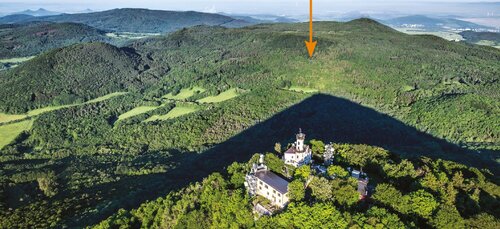
Figure 2. Aerial view of the Mt. Milešovka part of the České Středohoří/Central Bohemian Uplands with Mt. Milešovka in the foreground. The Březina Peat-bog (Březina National Nature Reserve, a Natura 2000 site) is situated on the slope of Bukový vrch/Beech Hill, see arrow. © Jiří Jiroušek, www.nebeske.cz, credits for basic photograph, edited/cut-out.
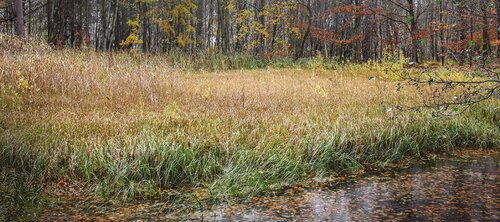
Figure 3. The Březina peat-bog. View of the peat-bog interior © Petra Marešová.
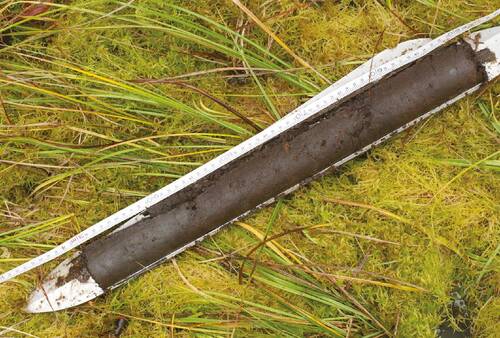
Figure 4. Drilling from the Březina peat-bog. Freshly sampled sediment core in boring chamber tool, basis of the profile. The grey part at the bottom corresponds to starting sedimentation at the beginning of the Holocene, followed by sedimentation of a woody fen. © Jindřich Prach.
Detailed evidence from pollen and plant macro-residue analysis
In the Březina NR sediments, it has been found that biological remains, particularly pollen grains and plant seeds, are preserved very well. At the beginning of the Holocene, fine clastic and for ~30% organic material settled in the small waterbody of a stony landslide. The ratio of pollen of herbs to woody plants was high, reaching 28%, and late glacial elements of cold steppes were represented, e.g. the joint pine Ephedra distachya type and the juniper Juniperus type (Fig. 5). The main sedimentation of mostly organic material took place 9,500 to 8,400 years ago. Heliophilous trees like williow (Salix spp.), the Green alder (Alnus viridis), and subsequently the European hazelnut (Corylus avellana) spread in the immediate vicinity of the site, whereby Corylus pollen reached a proportion of 37% in the period approximately 8,900 years ago (Fig. 5). However, in the record of plant macro-residues, best reflecting the local representation of woody species, only birch (Betula spp.) seeds were recorded in this stage (Fig. 6). About 8,600 years ago, broad-leaved deciduous forest species of the temperate zone, such as linden (Tilia spp.), maple (Acer spp.), and ash (Fraxinus spp.), increased their relative abundance, whereby Tilia pollen grains reached a proportion of 13% (Fig. 6). In this period, the site very probably had a small open waterbody, which is confirmed by the presence of water flea (Daphnia spp.) residues which were part of the plankton (detailed surveys of invertebrate communities in the palaeoecological record are also possible, but have been still awaiting processing). Plants of stagnant waters belonging to the pollen types of Alisma plantago-aquatica, Myriophyllum spicatum, and Potamogeton natans grew here (Fig. 5). Also the Bottle sedge (Carex rostrata), indicating oligotrophic conditions, occurred locally. Subsequently, the proportion of pollen grains of the Bulrush (Typha latifolia) increased (Fig. 5) locally, confirmed by findings of its seeds. In the time 8,500 years ago, the oak (Quercus spp.) pollen grains reached a proportion of nearly 50%, which indicates an expansion of oak forests. The presence of pollen grains of shrubs like the European cornel (Cornus mas), highbush cranberry (Viburnum spp.), and rowan (Sorbus spp.) were recorded in the samples, too (Fig. 5). The pollen grains of the European mistletoe (Viscum album), which were continually captured at a proportion of approx. 1%, indicate a mild, oceanic climate (Walas et al. 2022).
Figure 5. Diagram of simplified pollen analysis results from the Březina National Reserve. Rows represent sediment layers at a particular depth; curves show how the ratios of pollen or spores of plant species changed over time. These ratios reflect to a certain extent which plants grew in the vicinity. Relative abundance of pollen and spore types are given in black, the grey area indicates a 10× increase. The radiocarbon calibrated dates before the present [cal BP], which help us determine the age of the layers, are plotted in the margin of the diagram. The first column shows the ratio between trees, herbs and fern spores. The layer at 235 cm marks a hiatus, which is the period when peat sediment was not deposited or was decomposed, causing a not yet precisely dated gap in the record. AP – shrub and tree pollen, AQ – pollen and spores of aquatic and hygrophilous species.
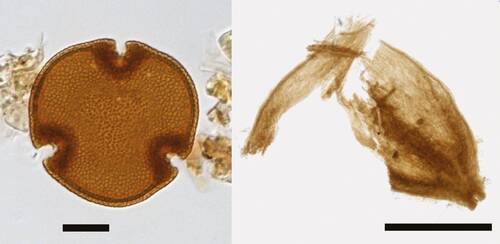
Figure 6. Examples of plant remains preserved in peat and lake sediments.
• on the left – Pollen grain of Tilia. Thanks to the resilient surface layer, the pollen grains are conserved in the sediments, and can be extracted from it by chemical processing. In the studied profile at Březina, Tilia pollen grains were abundant in 8,000–9,000-year old layers, up to a proportion of 13 %. Scale bar = 10 µm.
• on the right – Seed of birch (Betula spp.). Larger plant residues can be separated using sieves with a calibrated mesh diameter. The presence of the seeds is evidence of local occurrence of Betula in the same period. Scale bar = 1 mm. © Petra Marešová & Alexandra Bernardová.
It is evident that vegetation overgrowing similarly to today took place already approx. 8,000 years ago or in the following millennia (a more precise dating of these layers with abundant seeds and pollen of Typha, Carex and Sparganium is a task for further research). The aquatic habitat did not disappear completely, as indicated by the occurrence of seeds of the carnivorous Waterwheel plant (Aldrovanda vesiculosa), now extinct in the Czech Republic. The analysed profile includes a hiatus, thus probably a time gap in the record, characterised by a layer composed of rusty sand and carbon. This could reflect a single event such as a flush of eroded material, e.g. after a fire, or a longer time period influenced by desiccation or decomposition of the sediment. Comparison with pollen data from the former Komořany Lake, reflecting a regional pollen fallout in the middle Holocene (Houfková et al. 2017), indicates that this hiatus may have lasted for hundreds to a few thousand years. This is suggested by the simultaneous appearance of beech and fir in the Březina sediment above the 235 cm layer. In the record from Komořany Lake, this happened 6,500 to 5,500 years ago. However, in the case of a small waterbody in the middle of closed vegetation, pollen fallout differs from that deposited in a large water reservoir in the large Most Basin, so the dates do not necessarily have to correspond to each other exactly. Specification of the duration of the hiatus needs further research and more radiocarbon dates. Subsequently, beech trees spread, their pollen reaching a proportion of 16%. The sedimentation of solid organic matter ended at the beginning of the early Middle Ages 1,500 years ago, a time to which the spread of oak-hornbeam forests and human influence in the site’s vicinity can be attributed according to the record.
The pilot study has confirmed that a palaeological record is detailed enough and deserves continued research, a more precise time specification, a more detailed profile and the introducing analyses (e.g. carbon revealing fires in the vicinity, diatoms indicating change in water trophic state, etc.). A follow-up study may answer questions regarding e.g. the influence of prehistoric human activities and fires on vegetation development (also in connection with other processes like erosion, vegetation overgrowing, changes in water regime, etc.).
Recommendations
The study has unequivocally demonstrated the high palaeoecological value of the sediments deposited on the bottom of the Březina NR peat-bog. Sediments for palaeoecological studies can only be assessed if the layer sequence is not disturbed. The use of heavy machines for sediment removal in such a small area as the Březina NR fen bog, would impact all parts of the sediment. Shifting and/or mixing would disrupt the stratigraphy and thus invalidate the record. The formerly considered use of heavy machines therefore appears to be completely inappropriate there.
The present study has outlined the opportunities and high potential of a further detailed palaeoecological research. Since this is a dynamic field in which the possibilities are constantly increasing (e.g. research on ancient DNA thanks to constantly improving methodology), it is important to preserve rare archives such as the sediments in the Březina NR. At the same time, it appeared that the site has undergone similar changes – vegetation overgrowing – as we observe today – probably more than once in its long history. Despite that, the valuable habitats have persisted there. We should take into account the “protection of the entire geobiocenosis” as defined in the conservation objective more than half a century ago, i.e. the protection of the ‘geo-’ of the ecosystem including its sediment and long-term dynamics, not only the preservation of the conservation objects such as the Northern crested newt.
The presented study is the first in a series of articles on the application of palaeoecology in nature conservation. The reader can find more in the final report (https://drusop.nature.cz) or in a forthcoming more complete technical publication. ■
- - - -
The list of references is attached to the online version of the article at www.casopis.ochranaprirody cz
- - - -
Cover photo:
Figure 1. Sediment collection at the Březina peat-bog © Jindřich Prach.


